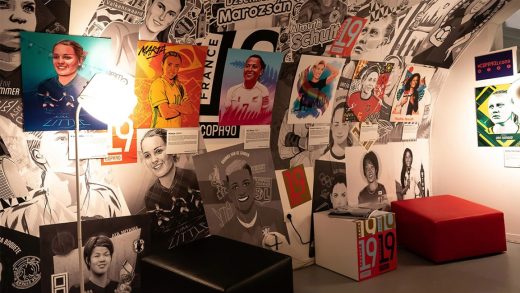Sports media is going direct to consumer—and Copa90 wants to be the Glossier of soccer
As the reigning Ballon d’Or winner, Ada Hegerberg is the best female soccer player on the planet. But the Norwegian star, who plays professionally in France for Olympique Lyon, has refused to suit up for Norway since 2017 over how women’s soccer is treated in her home country, not just in pay but training facilities, travel, and more. The 23-year-old star was obviously missed at the 2019 Women’s World Cup, but she did make it to France, playing at the Copa90 clubhouse in Paris during the tournament.
She just wasn’t playing soccer.
Hegerberg spoke on a panel, hung out with fans, and shot some exclusive video content. This is exactly why the London-based digital sports-media company set up camp in France for the whole World Cup, to be a place where soccer, music, and fashion could mix and mingle. A place where the best player in the world could come to play a retro kids game called Buckaroo.
Brands have long talked about the need to forge a more direct relationship with consumers, and many have tried to do so through proprietary media and content, like Dollar Shave Club’s Mel magazine, or Red Bull’s Media House content juggernaut. The opposite move—a media company successfully diversifying into consumer products—is much less common, though Glossier and Barstool Sports are among the rare exceptions.
For Copa90 (a 2019 Fast Company Most Innovative Company) the goal is to build, according to chief business officer James Kirkham, “the largest, active, digitally-connected, cross-platform football fanbase in the world” around a combination of fan-centric programming, products, and services. Now that the Women’s World Cup is over, looking back at the Copa90 clubhouses in Paris and Lyon may become a defining moment in how the company evolves from here.
“For us, football is at the heart of popular culture,” says Kirkham. “You can have a musician hanging out with a footballer, goofing around playing video games and things like that. Or listening to someone like Abby Wambach speak, on topics that go beyond the game. It’s about creating that physical space so you can touch it, feel it, and be a part of it, rather than just scrolling over a graphic on Instagram.”
Rebecca Smith, Copa90’s head of women’s football and a former pro and international player, says the company’s focus on the culture of soccer, not just the game, has helped it forge strong relationships with players. “Typically at big events like this, the players are on lockdown and not allowed to do any media outside official channels,” says Smith. “But despite that, we had so much engagement with the players, and when they were able to they wanted to come and hang out. We had a lot of players, ex-players, and key people from the game on our podcast and in the clubhouse, and we got a lot of great feedback on it.”
With Copa90 clubhouse hosts like Chelcee Grimes, a BBC pundit and pro footballer who also just happens to be an award-winning artist and songwriter (for artists like Dua Lipa and Kylie Minogue), it’s no surprise the place attracted guests like Hegerberg and Wambach, as well as former England player (and BBC pundit) Alex Scott, even men’s legends like Australia’s Tim Cahill and former Premier League and Champions League winner Mikaël Silvestre.
The idea for the Women’s World Cup clubhouses started at the men’s tournament in Russia, where Copa90 first experimented with setting up a clubhouse in Moscow. “The Russian clubhouse was much more about drinking a beer and watching a game with people, and there [was] some of that [in France], but because of the talent we were able to bring in, and the connection to the players, it became the ultimate football hangout.”
It also is a peek into how Kirkham and Copa90 leadership see the future of their business: a media company that feels more like a club. The Paris clubhouse became a production hub, in which podcasts, art shows, interviews, apparel, and more were turned into content the brand could then share with its fans that couldn’t make the journey to France. When a moment like Alex Morgan’s “sipping tea” goal celebration against England in the World Cup semifinal happened, by the next day Copa90 fans could buy a special edition T-shirt to mark the occasion.
And it’s not just about reporting on moments around the sport. Copa90 wants to help create those moments.
The soccer clubhouse is the media version of direct-to-consumer brands such as Warby Parker, Bonobos, and Glossier using brick-and-mortar retail to be a physical space to experience the brand. While the Women’s World Cup clubhouses embodied that ethos, as the club football season around Europe and most of the world gets set to kick off in the next month or so, Copa90 is using the lessons learned in France to further move beyond content. The company plans to host more events, focusing on the idea of its fans as club members. So far, through its newsletter, the company is giving subscribers first looks at store content, new apparel, and events before anyone else. Eventually, the goal is to extend that membership into a low-monthly-price subscription offering, adding sports-betting tips and a game ticket exchange.
“It all led us to a bigger direct-to-consumer proposition which is at the heart of the business today, where we want to create this connected fan club,” says Kirkham.
Fast Company , Read Full Story
(24)



